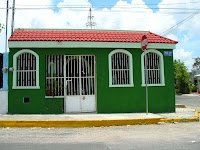THIS POST: PLACES
SUBJECT: MERIDA, THE WHITE CITY
When people saw that Merida’s original buildings were of white limestone, the streets were cleaned twice daily, and the white guyabera with matching white pants, hat, and sandals rpresented the formal dress of the Yucatecan gentleman, Merida got the nickname “The White City”.
Minimal research turned up the fact that the nickname “White City” is not unique to Merida. There are “White Cities” scattered throughout the globe, including five cities in the United States, four in the United Kingdom, and one each in Israel, Greece, Russia, Canada, Peru, Portugal, Serbia, Italy, Sweden, and Australia! (I never knew that!)
Today, it is almost cost prohibitive to use white limestone for other than trim and decorative purposes. Houses are primarily constructed of mamposteria (stacked stone), and more commonly, cement building blocks. A thin layer of plaster, usually of a cement base, is used to surface the stone or cement block, which is then painted. It is at this point you can say hasta la vista to the theme of “The White City”!
The Mexican people are a vibrant and joyous lot and this spills over and is reflected in every aspect of their culture, including the colors they choose for their homes (and I love it)! Take a look at some of the houses I have photographed within the city limits of Merida, The White City: (photographs shown without commentary - none needed!)
When people saw that Merida’s original buildings were of white limestone, the streets were cleaned twice daily, and the white guyabera with matching white pants, hat, and sandals rpresented the formal dress of the Yucatecan gentleman, Merida got the nickname “The White City”.
Minimal research turned up the fact that the nickname “White City” is not unique to Merida. There are “White Cities” scattered throughout the globe, including five cities in the United States, four in the United Kingdom, and one each in Israel, Greece, Russia, Canada, Peru, Portugal, Serbia, Italy, Sweden, and Australia! (I never knew that!)
Today, it is almost cost prohibitive to use white limestone for other than trim and decorative purposes. Houses are primarily constructed of mamposteria (stacked stone), and more commonly, cement building blocks. A thin layer of plaster, usually of a cement base, is used to surface the stone or cement block, which is then painted. It is at this point you can say hasta la vista to the theme of “The White City”!
The Mexican people are a vibrant and joyous lot and this spills over and is reflected in every aspect of their culture, including the colors they choose for their homes (and I love it)! Take a look at some of the houses I have photographed within the city limits of Merida, The White City: (photographs shown without commentary - none needed!)






























My home didn’t make it to this wonderful, colorful gallery! It pales in comparison, painted tan with white trim, with black wrought iron accessories. But I have a confession to make:
I love each and every home that is pictured here! This is just a small part of what makes Mexico, “Mexico”, and I wouldn't change a thing!!!
(Blogger Villain got me while I was trying to post these pictures! Try as I may, this is the best I could come up with!)































